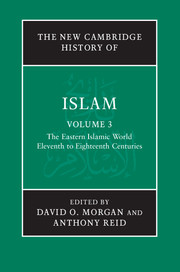Book contents
- Frontmatter
- Introduction: Islam in a plural Asia
- PART I THE IMPACT OF THE STEPPE PEOPLES
- PART II THE GUNPOWDER EMPIRES
- PART III THE MARITIME OECUMENE
- 9 Islamic trade, shipping, port-states and merchant communities in the Indian Ocean, seventh to sixteenth centuries
- 10 Early Muslim expansion in South-East Asia, eighth to fifteenth centuries
- 11 Follow the white camel: Islam in China to 1800
- 12 Islam in South-East Asia and the Indian Ocean littoral, 1500–1800: expansion, polarisation, synthesis
- 13 South-East Asian localisations of Islam and participation within a global umma, c. 1500–1800
- 14 Transition: the end of the old order – Iran in the eighteenth century
- PART IV THEMES
- Glossary
- Bibliography
- Index
- References
12 - Islam in South-East Asia and the Indian Ocean littoral, 1500–1800: expansion, polarisation, synthesis
from PART III - THE MARITIME OECUMENE
Published online by Cambridge University Press: 28 March 2011
- Frontmatter
- Introduction: Islam in a plural Asia
- PART I THE IMPACT OF THE STEPPE PEOPLES
- PART II THE GUNPOWDER EMPIRES
- PART III THE MARITIME OECUMENE
- 9 Islamic trade, shipping, port-states and merchant communities in the Indian Ocean, seventh to sixteenth centuries
- 10 Early Muslim expansion in South-East Asia, eighth to fifteenth centuries
- 11 Follow the white camel: Islam in China to 1800
- 12 Islam in South-East Asia and the Indian Ocean littoral, 1500–1800: expansion, polarisation, synthesis
- 13 South-East Asian localisations of Islam and participation within a global umma, c. 1500–1800
- 14 Transition: the end of the old order – Iran in the eighteenth century
- PART IV THEMES
- Glossary
- Bibliography
- Index
- References
Summary
Over the past half-century historians have endeavoured to moderate the exaggerated importance long attached to 1498 and the arrival in the Indian Ocean of a small band of Portuguese. The Portuguese introduced consistent reportage in a language still relatively accessible, and in this sense 1498 may stand as a turning point in the literature. Asia was henceforth linked to Europe directly, and the exchange of ideas and technologies was possible without Arab or Central Asian mediation. Apart from an aggressive naval strategy and more effective technologies of navigation, time-keeping and warfare, however, the Portuguese had little more to offer by way of modernisation of commerce, science and technology. They made the great effort to join the maritime trade of the Indian Ocean precisely because it was already highly developed, delivering spices to Europe through Alexandria and Venice, and using some sophisticated financial techniques unknown to the Portuguese.
To this Muslim-dominated trade the Iberians initially brought only plunder and disruption, and were naturally seen as a scourge. In the longer term the establishment of a direct maritime route of trade around the Cape of Good Hope was profoundly important in depriving the Islamic commercial networks of their monopoly of east–west trade and intellectual mediation. It also introduced to the world of the Indian Ocean a sharp polarisation between Islam and its rivals from which the maritime world had previously been spared.
- Type
- Chapter
- Information
- The New Cambridge History of Islam , pp. 427 - 469Publisher: Cambridge University PressPrint publication year: 2010
References
- 1
- Cited by



